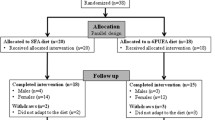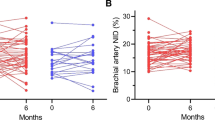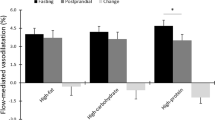Abstract
The objective of this study was to investigate the relationship between the composition of FA in serum lipids, a marker of dietary fat intake, and vascular reactivity using a combination of cross-sectional and intervention approaches. Fifty-six middle-aged subjects were evaluated in a cross-sectional protocol regarding the relationship between the proportion of FA in serum cholesterol esters and vascular reactivity using measurements of forearm blood flow (FBF) with venous occlusion plethysmography during hyperemia. Another 19 middle-aged subjects were given a rapeseed oil-based diet rich in mono-and polyunsaturated FA or a control diet rich in saturated FA during two consecutive 4-wk periods separated by a 4-wk washout period. In the cross-sectional protocol, the FA 18:0 and 20:3 were positively related to resting FBF, whereas an inverse relationship was seen for the FA 20:5 and 22:6 (P<0.05−0.01). Opposite relationships were seen between these four FA and the relative increase in maximal FBF during hyperemia (P<0.05−0.01). In the intervention protocol, the saturated diet increased resting FBF, as well as the relative increase in maximal FBF during reactive hyperemia, compared to the diet rich in unsaturated FA (P<0.05). Both the cross-sectional and intervention data support the view that the composition of serum FA, which at least partly reflects the quality of dietary fat, plays a role in determinations of vascular reactivity.
Similar content being viewed by others
Abbreviations
- CHD:
-
coronary heart disease
- E%:
-
energy percent
- FBF:
-
forearm blood flow
- NO:
-
nitric oxide
- RO:
-
rapeseed oil-based diet
- SAT:
-
control diet high in saturated FA
References
Castelli, W.P., Doyle, J.T., Gordon, T., Hames, C.G., Hjortland, M.C., Hulley, S.B., Kagan, A., and Zukel, W.J. (1997) HDL Cholesterol and Other Lipids in Coronary Heart Disease. The Cooperative Lipoprotein Phenotyping Study, Circulation 55, 767–772.
Caggiula, A.W., and Mustad, V.A. (1997) Effects of Dietary Fat and Fatty Acids on Coronary Artery Disease Risk and Total and Lipoprotein Cholesterol Concentrations: Epidemiologic Studies. Am. J. Clin. Nutr. 65, 1597S-1610S.
Mensink, R.P., and Katan, M.B. (1992) Effect of Dietary Fatty Acids on Serum Lipids and Lipoproteins. A Meta-analysis of 27 Trials, Arterioscler. Thromb. 12, 911–919.
Eritsland, J. (2000) Safety Considerations of Polyunsaturated Fatty Acids, Am. J. Clin. Nutr. 71, 197S-201S.
Tsimikas, S., and Reaven, P.D. (1998) The Role of Dietary Fatty Acids in Lipoprotein Oxidation and Atherosclerosis, Curr. Opin. Lipidol. 9, 301–307.
Furchgott, R.F., and Zawadski, J.V. (1980) The Obligatory Role of Endothelial Cells in the Relaxation of Arterial Smooth Muscle by Acetylcholine, Nature 299, 373–376.
Palmer, R.M., Ferrige, A.G., and Moncada, S. (1987) Nitric Oxide Release Acounts for the Biological Activity of Endothelium-Derived Relaxing Factor, Nature 327, 524–526.
Rosei, E.A., Rizzoni, D., Castellano, M., Porteri, E., Zulli, R., Muiesan, M.L., Bettoni, G., Salvetti, M., Muiesan, P., and Giulini, S.M. (1995) Media: Lumen Ratio in Human Small Resistance Arteries Is Related to Forearm Minimal Vascular Resistance, J. Hypertens. 13, 341–347.
Tagawa, T., Imaizumi, T., Endo, T., Shiramoto, M., Harasawa, Y., and Takeshita, A. (1994) Role of Nitric Oxide in Reactive Hyperaemia in Human Forearm Vessels, Circulation 90, 2285–2290.
Vallance, P., Collier, J., and Moncada, S. (1989) Effects of Endothelium-Derived Nitric Oxide on Peripheral Arterial Tone in Man, Lancet 2, 997–1000.
Smedman, A.E., Gustafsson, I.B., Berglund, L.G., and Vessby, B.O. (1999) Pentadecanoic Acid in Serum as a Marker for Intake of Milk Fat: Relations Between Intake of Milk Fat and Metabolic Risk Factors, Am. J. Clin. Nutr. 69, 22–29.
Zock, P.L., Mensink, R.P., Harryvan, J., deVries, J.H., and Katan, M.B. (1997) Fatty Acids in Serum Cholesteryl Esters as Quantitative Biomarkers of Dietary Intake in Humans, Am. J. Epidemiol. 145, 1114–1122.
Sarabi, M., Millgård, J., and Lind, L. (1999) Effects of Age, Gender and Metabolic Factors on Endothelium-Dependent Vasodilation—A Population Based Study, J. Intern. Med. 246, 265–274.
Lind, L., Sarabi, M., and Millgård, J. (1998) Methodological Aspects of the Evaluation of Endothelium-Dependent Vasodilatation in the Human Forearm, Clin. Physiol. 18, 81–87.
Jones, B., and Kenward, M.G. (1989) Monographs on Statistics and Applied Probability 34: Design and Analysis of Cross-Over Trials, Chapman & Hall, London.
Steinberg, H.O., Tarshoby, M., Monestel, R., Hook, G., Cronin, J., Johnson, A., Bayazeed, B., and Baron, A.D. (1997) Elevated Circulating Free Fatty Acid Levels Impair Endothelium-Dependent Vasodilation, J. Clin. Invest. 100, 1230–1239.
Lind, L., Fugmann, A., Vessby, B., Millgård, J., Berne, C., and Lithell, H. (2000) Impaired Endothelial Function Induced by Free Fatty Acids Is Reversed by Insulin, Clin. Sci. 99, 169–174.
Öhrvall, M., Berglund, L., Salminen, I., Lithell, H., Aro, A., and Vessby, B. (1996) The Serum Cholesterol Ester Fatty Acid Composition but Not the Serum Concentration of α-Tocopherol Predicts the Development of Myocardial Infarction in 50-Year-Old Men: 19 Years Follow-up, Atherosclerosis, 127, 65–71.
Dakak, N., Husain, S., Mulcalhy, D., Andrews, N.P., Panza, J.A., Waclawiw, M., Schenke, W. and Quyyumi, A.A. (1998) Contribution of Nitric Oxide to Reactive Hyperemia: Impact of Endothelial Dysfunction, Hypertension 32, 9–15.
Sarabi, M., Vessby, B., Millgård, J., and Lind, L. (2001) Endothelium-Dependent Vasodilation Is Related to Eatty Acid Composition of Serum Lipids in Healthy Subjects, Atherosclerosis 156, 349–355.
Davda, R.K., Stepniakowski, K.T., Lu, G., Ullian, M.E., Goodfriend, T.T., and Egan, B.M. (1995) Oleic Acid Inhibits Endothelial Nitric Oxide Synthase by a Protein Kinase C-Independent Mechanism, Hypertension 26, 764–770.
Moers, A., and Schrezenmeir, J. (1997) Palmitic Acid but Not Stearic Acid Inhibits NO Production in Endothelial Cells, Exp. Clin. Endocrinol. Diabetes 105 (Suppl. 2), 78–80.
Shimokawa, H., and Vanhoutte, P.M. (1989) Dietary Omega-3 Fatty Acids and Endothelium-Dependent Relaxation in Porcine Coronary Arteries, Am. J. Physiol. 256, H968-H973.
Author information
Authors and Affiliations
Corresponding author
About this article
Cite this article
Lind, L., Södergren, E., Gustafsson, IB. et al. The types of circulating fatty acids influence vascular reactivity. Lipids 37, 1141–1145 (2002). https://doi.org/10.1007/s11745-002-1011-2
Received:
Revised:
Accepted:
Issue Date:
DOI: https://doi.org/10.1007/s11745-002-1011-2




